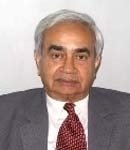Trishanku, Pervez Musharraf and Atal Behari Vajpayee
27 Mar, 2004 · 1350
PR Chari comments on the way that policies have oscillated between contradictory extremes in both Islamabad and New Delhi
Hindu mythology celebrates a pious king named Trishanku who devoted himself to virtuous deeds and austerities. Impressed by them, the sage Vishwamitra asked Trishanku to seek a boon. The King then asked Vishwamitra to ensure that when Trishanku died he could enter heaven with his body. Vishwamitra granted this boon. Ere long, Trishanku died, and Vishwamitra despatched his body to heaven. The devas were aghast, heaven could only be populated by souls. Nobody had ever entered heaven along with his body. So they pushed Trishanku back to earth. Bound by his vow Vishwamitra sent Trishanku back to heaven; equally determined, the devas pushed him back to earth. This happened several times. So Vishwamitra created a special heaven for Trishanku suspended between heaven and earth, Trishanku Swargam, in which the pious king ultimately found peace. An analogy is possible between Trishanku’s case and the dilemma in which Pervez Musharraf and Atal Behari Vajpayee find themselves.
Musharraf’s predicament arises from his imperative to balance the basic anomalies in Pakistani polity, some inherited, and some he created himself. These are easily recognizable, and were greatly exacerbated by the events following 9/11. How long could he sustain the fiction that Pakistan is not involved in the cross-border terrorism proceeding in Kashmir? How long could he sustain the illogic of fighting in America’s war on terrorism against the Taliban and al Qaeda in the west, but supporting cross-border terrorism in the east? Apart from these incongruities in the external sphere, there are equally obtuse contradictions in the area of internal governance. How long could the Americans be fobbed off with pledges that Pakistan would act decisively against the domestic Islamic fundamentalist groups that have proliferated across the country, but do little to uproot them or stop their support to global terrorism, but especially in Kashmir? How long could Musharraf promote his secular image in the country and abroad while exhibiting leniency towards the jihadists at home? Like Trishanku he remains suspended between opposite policy choices and cannot move decisively in any definite direction. His constant references to the need for resolving the Kashmir issue before Indo-Pak relations can be normalised and anointing it as the ‘core issue’ are explicable in this light; they are efforts to deflect attention from these dilemmas confronting Pakistan’s ruling elites in the military.
Vajpayee’s compulsions are no different. He needs to appear ‘moderate’ and represent the voice of reason before the international community. At the same time he cannot afford to displease the Hindu fundamentalists within the Sangh Parivar, particularly the RSS, which provides the manpower to fight the elections and is fast penetrating the BJP leadership. He needs to secure the Muslim vote, but not alienate the Hindu vote. This balancing act is, no doubt, difficult after Gujarat, but the need to keep juggling several balls in the air illumines his policy compulsions and choices. The cricket team’s tour to Pakistan was, consequently, permitted to burnish Vajpayee’s secular image. But the Advani yatra was simultaneously launched to consolidate the Hindu majority vote. The Agra and Lahore summit meetings were agreed to after declaring that no dialogue with Pakistan was possible unless cross-border terrorism ceased, and some 20 wanted criminals, provided asylum in Pakistan, were repatriated. But these meetings were agreed to despite these conditions not being met. Several reasons for this volte face were given, but the most plausible was that American pressure was obtaining. The policy in vogue is to broadcast the independence of India’s foreign policy and deny any US influence upon it, but accept its urgings in practice. In this way, the rightist elements within the Sangh Parivar would not be unduly offended, but the United States would be appeased. Vajpayee, like Trishanku, needs to oscillate between opposite worlds.
Can President Bush be cast in Vishwamitra’s role, arbitrating the fortunes of the Trishankus in South Asia? The US’s physical presence in South Asia and its neighbouring regions is growing exponentially, and its influence on India has enormously increased – witness the rhetoric depicting its metamorphosis into a “strategic ally” – while Pakistan has been incorporated into the US war on terror as a “frontline ally”. India had sought this status earlier by offering its bases for use by US aircraft in its war against terrorism launched against Afghanistan. This was not accepted by the Bush administration. Now Pakistan has been offered the status of a non-NATO ally, an offer also made to India. Quite transparently, the attempt by this ploy is to gain entry into the decision-making processes of India and Pakistan. Therefore, whilst carving out its version of a “Trishanku Swargam” for the two adversaries, the US is also seeking to bring them more firmly within its control.


